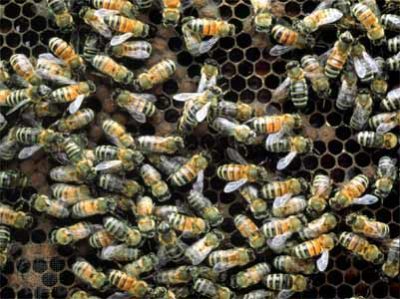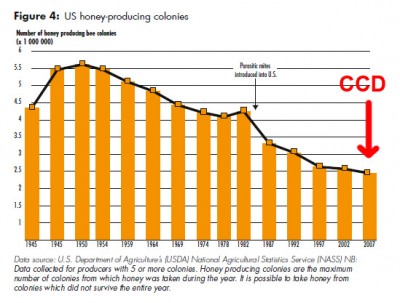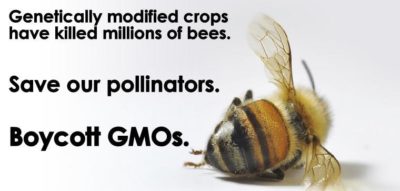America is on the way to becoming an agricultural police state, courtesy of the henchmen at Monsanto – you know, the ones President Barack Obama appointed to supervisory positions at a host of federal agencies. In May 2012, Off The Grid News and the Prairie Advocate broke the story about Gestapo tactics at an Illinois beekeeper’s home. Terry Ingram, a 58-year-old Apple River beekeeper, arrived home to find $5,000 worth of honeybees had all been confiscated by members of an unelected state agency which appears to answer to nary a soul.
Folks from the Illinois Department of Agriculture arrived at Terry Ingram’s home on a Sunday without a warrant or legal document of any type and destroyed all of his bee hives. State bee laws indicate that such inspections are to be conducted during regular business hours. A government employee working a Sunday is quite uncommon. Were Ingram’s hives just a front for a meth lab or diamond smuggling scam? Absolutely not. The Illinois beekeeper’s only crime was in possessing what is being called a Round-Up Ready queen bee. The mega biotech companies state publicly that they are now funding bee research. In the wake of this announcement by Monsanto, Bayer, and Sygenta, the trials and tribulations of the Illinois beekeeper take on new meaning.
Could a Round-Up Ready queen bee patent be coming down the pike? Such a possibility is terrifying. Imagine a world where nothing but genetically modified bees existed to pollinate your garden or farm. It would take several generations of queens to accomplish such a scenario, but once the first GMO queen bee springs into action, the days of the natural honeybee are numbered.
As previously reported by Off The Grid News, the dwindling number of bees (not just in America, but around the world) are causing alarm for scientists and agricultural experts. Pollinating crops without bees would not be impossible, but it would be extremely difficult and expensive. Pesticides, like the ones so loved by Monsanto executives who rake in the big bucks from their purchase, are often blamed for the loss of honeybees.
The Ultimate Guide to Keeping Stronger Colonies and Healthier, More Productive Bees
Both Syngenta and Bayer make neonicotinoids, a type of pesticide which has been linked to the decline of the bee population. The two companies are apparently attempting to garner some good press and are working together to fund bee research at Ohio State University and Iowa State University. The research will reportedly focus upon the impact of insecticide seed treatment dust on bees.
Terry Ingram knows the effect of pesticides on the bee population all too well. The Apple River beekeeper had this to say when discussing one of Monsanto’s top-selling products with Off The Grid News:
“Farmers are spraying Round-Up on their corn, their soybeans. When I first experienced it was in ’96. My wife and I were running over 250 hives at that time and they first came out with Round-Up and they sprayed with an airplane. We weren’t home at the time. We were in Canada. I was directing a nature camp in Canada for a week. Before we left, I left three or four supers of room for the bees to put their honey in while I was gone so I wouldn’t have to worry about swarming. I came back from Canada. There were no bees flying. ‘What in the world? Did they all swarm? I can’t believe they’d all swarm.’ So I went out and looked at them and every queen was still there and a small amount of brood and a small amount of adults.
“Instead of having three supers of bees—supers are the boxes that are sitting on top of each other for honey—and instead of having those filled with bees and honey, there weren’t even enough bees to cover the young bees in the bottom of the nest. They just started to recover from that and I have determined since then that it takes a super about 40 pounds of honey for a colony to get back on its feet from being sprayed once. So they had just about gotten back on their feet in three weeks and they would hit them with another. The planes would come over and be dropping Round-Up again. They dropped them every three weeks that summer and by the end of the summer, I had no bees left.”
Buying new packages of bees to start from scratch every year was an expensive endeavor. Ingram had one queen who appeared to have developed a resistance to the chemical pesticides being sprayed on nearby farms. She lived through three summers of spraying.  All of Ingram’s honeybees were killed after the seizure by the state, including the Round-Up Ready survivor.
All of Ingram’s honeybees were killed after the seizure by the state, including the Round-Up Ready survivor.
Bayer is also throwing large wads of cash at a center devoted to the study of bee health in North Carolina. Monsanto uses a pesticide coating on its seeds. The bio-tech giant is hosting a bee solutions summit in June. The way to save the bee population is not through research or the creation of a Round-Up Ready queen – merely ending the unhealthy practice of dousing the land with pesticides would do the trick real quick. Protecting our food supply should not matter to just Democrats, Republicans, or Libertarians, but to everyone who wants to live.
Secret Garden of Survival author and homesteading expert Rick Austin shared his insight into the inner workings of bee colonies with Off The Grid News. Austin explained that once a queen is chosen, she leaves her hive on a wedding flight (beekeepers call this her “maiden flight”). While on her journey, the queen mates with multiple drones and stores the implanted sperm to generate hordes of offspring throughout her life (from 1,000 to 2,000 per day). All of the offspring of a Round-Up Ready queen would become GMO baby bees.
Those already familiar with Monsanto’s tactics know that the biotech company is not shy about suing farmers who even inadvertently “benefited” from their products. Corn farmers have been exceptionally hard hit by problems stemming from fertilizer blowing onto their crops. Following Monsanto’s already established legal arguments, anyone who somehow utilizes one of their patented GMO products owes the politically powerful company a fee. If the entire world is one day inhabited solely by Round-Up Ready queen bees, all the crops and flowers which are fertilized by free roaming honeybees would carry a Monsanto licensing fee requirement.
Rick, a.k.a. “The Survivalist Gardener” had this to say about Monsanto and the future of the bee population:
“They have no interest in research. They already know what their products do to the bee population—all they want to do is sell more stuff. Round-Up Ready corn weeds have already become more resistant to the pesticide, prompting the need for the use of even more harsh chemicals to achieve the same result. I had not heard anything about a Round-Up Ready queen bee before we spoke, but it makes sense with what I had heard about a bee research center out in the country. No good can come from the research or such a queen. We already know we can’t trust them [Monsanto] to tell the truth. They are killing all of us. I wonder if they even eat their own food. Probably not – they know what’s in it. A total of 70 percent of the world’s food supply needs to be pollinated by bees. If the bee population dies, we will too.”
Live Greener. Live Smarter. Live Better!
The Terry Ingram Backstory
Terry Ingram had this to say about the bee population confiscation during an Off The Grid News interview with Bill Heid:
“Well, the story actually began last summer when Susan Kivikko was appointed as bee inspector for the state of Illinois. She went up to the Stateline Beekeepers Association picnic in July of last year and I gave her a frame and I asked her to determine what chemical was in that frame that the bees would not even walk on it, would not walk on the frame at all. She took the frame and the only thing she found was American foulbrood, which we know that that doesn’t stop bees from walking on it. And I asked her how come she didn’t have it tested for any of the chemicals that I asked her too. ‘The department didn’t have money enough for that.’ So then later on that summer she wanted to come up and inspect my bees and I said, ‘No. No sense in doing that because it’s a waste of taxpayers’ money. You don’t know what you’re looking for.’ We did have a hearing on April 4 [2012] and at that time I was able to show the court that the inspector and her boss, Steve Chard, a chief apiary inspector in Illinois, there is no requirement that they know anything about bees to be appointed to that position.”
 Terry Ingram very logically pointed out during the hearing the lack of common sense used when allowing a person with zero knowledge of beekeeping to be placed in charge of said beekeeping. Although Ingram did acknowledge that Susan Kivikko had spent a few years helping her husband care for a few bee colonies, the ability for the state to let a complete novice govern our dwindling bee population still needed to be addressed. According to Ingram, who is also credited on a national level for his Bald Eagle conservation efforts, revealed that Illinois used to mandate bee inspectors pass a test before they were considered for employment.
Terry Ingram very logically pointed out during the hearing the lack of common sense used when allowing a person with zero knowledge of beekeeping to be placed in charge of said beekeeping. Although Ingram did acknowledge that Susan Kivikko had spent a few years helping her husband care for a few bee colonies, the ability for the state to let a complete novice govern our dwindling bee population still needed to be addressed. According to Ingram, who is also credited on a national level for his Bald Eagle conservation efforts, revealed that Illinois used to mandate bee inspectors pass a test before they were considered for employment.
The first experience longtime beekeepers in Ingram’s region ever met an inspector was after his wife, who was the Stateline Beekeepers Association secretary, was prompted by members to request such a visit. The responsible beekeepers wanted a state inspector to review the health of their broods. It took two weeks for the inspections to begin and the agent had difficulty finding any foul brood (common problem) incidents. The disease does not harm the honey or humans, only the bees themselves. Inspections after the first meeting were erratic, about one per year, with only a sampling of the hives actually tested.
In 2011, at a beekeeper’s picnic, Terry Ingram presented the frame of honeycomb that the bees did not want to be around to Susan Kivikko. He wanted to know what chemicals might be on the comb, but the agricultural representative reportedly said that the state only has the funds to check for foul brood (which harms no one) and not chemicals—which obviously do prompt unhealthy consequences.
Many months later Ingram was ultimately told that the bee police had found “foulbrood” in some of his hives. Foulbrood is a disease which afflicts the honeybees before they reach adulthood while they are still in cells. It is a fatal disease of honeybee larvae caused by one of several types of bacteria. Despite the claim of only some of the hives being an issue, the state took all of his colonies. The experienced beekeeper maintains that the state agent confused chilled brood with foul brood. Unlike foulbrood (a disease), chilled brood is a result of the developing bees not being kept warm enough and dying. If there are not enough nursery bees to tend to the developing brood, they will die. Ingram stated chilled brood is common in all his hives because Round-Up kills all of the adult bees.
The Illinois beekeeper also added:
“When you lose enough bees you don’t have enough bees to keep that brood in the cluster and so the brood that’s left outside the cluster will chill over two or three days and die. And I call that chilled brood and that’s what she’s mistaking—and all the inspectors are mistaking that—for American foulbrood. When I was breeding my own bees, before they were killed by Round Up, I had foulbrood in one hive. I left it there all summer, just to see if the other hives would pick it up. They never did. That’s when I knew that it’s not as bad as people let on. Bees can take care of it.
“I had an inspector come in and examined for it, and he said the yard was clean, and I knew it wasn’t. There is no way that any beekeepers are going to be able to spend $60 to send a sample to a lab in Maryland, to find out he has foulbrood. The sample may have foulbrood, but it doesn’t say that the rest of the hive, or his other 5, 15, or hundred hives have it. He can’t go and destroy his hives because one sample has detected it.”
Beehives may look messy on the outside, but keepers have long claimed that on the inside, they are among the cleanest places in the entire world. The bees lick everything to make it clean. Terry noted that if honeybees find any type of disease or other unsavory problem, they cloak it in propolis—a natural antiseptic. The process protects the rest of the hive’s population.
After his bee population was seized, a story about Terry Ingram stating the he had $5,000 worth of bees and bee hives stolen appeared in the Prairie Advocate. Not long after the article was published, the reporter received a call from the local county Farm Bureau manager wanting to know where the bee story information had originated. The paper was told that the Illinois Department of Agriculture had not stolen but confiscated and destroyed the bees because of foulbrood.
For more than 15 years, Terry Ingram has been researching the impact of Round-Up on honeybees. He strongly believes that the body of data he has collected indicates that both the chemical pesticide and Colony Collapse Disorder (CCD) are to blame for the dwindling bee population. CCD is impacting bee populations from around the world. Had the state not taken and destroyed his Round-Up Ready queen bee, Ingram was going to raise her female offspring to determine if there was a genetic resistance to the pesticide present. When the Illinois Department of Agriculture seized and destroyed the beekeeper’s colony, they ruined 15 years of research on the effects of Round-Up on honeybees.
Perhaps that was the goal.
 Off The Grid News Better Ideas For Off The Grid Living
Off The Grid News Better Ideas For Off The Grid Living





